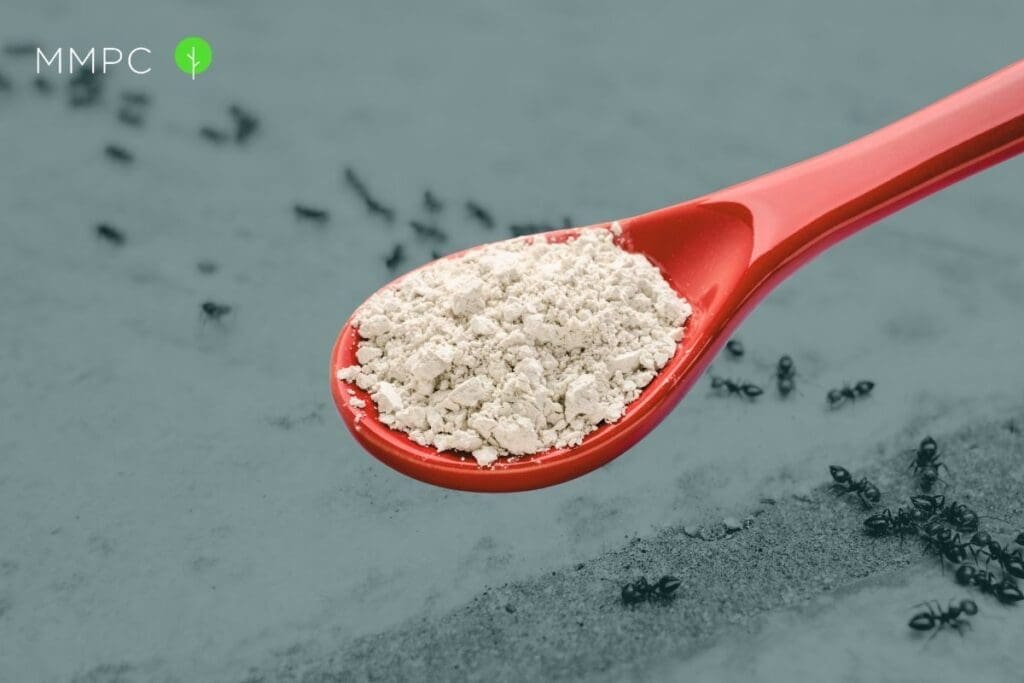
As a non-toxic alternative to chemical pesticides, diatomaceous earth provides an effective means of ant control that aligns with eco-friendly and sustainable pest management practices.
What is Diatomaceous Earth?
Diatomaceous earth, or diatomite, is a naturally occurring sedimentary rock that consists of fossilized diatoms, which are microscopic algae with intricate silicate shells. Diatomaceous earth used for pest control purposes is found in the form of finely ground powder derived from these fossilized remains.
When it comes to killing ants and other pests (like bed bugs), diatomaceous earth (DE) acts as a mechanical insecticide. When insects come into contact with DE, the microscopic particles adhere to their exoskeletons. As the insects move around, these sharp-edged particles cause abrasions and cuts, leading to the gradual loss of the insects’ waxy protective layer which serves to retain moisture. As a result, the insects become vulnerable to desiccation, or dehydration.
This dual mechanism of action—physical abrasion and desiccation—makes diatomaceous earth a potent and environmentally friendly solution for pest control.
Does Diatomaceous Earth Kill Ants?
Yes, diatomaceous earth is an effective DIY option for controlling common ant species found in the United States, such as odorous house ants and pavement ants.
The abrasive microscopic particles damages and compromises the ant’s exoskeleton, then the desiccating effect accelerates water loss. Together, these two mechanisms kill ants that come into contact with diatomaceous earth.
While DE is effective for killing individual ants, it’s important to note that it will not eradicate the colony. It only impacts ants that come into direct contact with it, such as foraging ants or those that venture into treated areas. However, the effects of DE application on an entire ant colonies is limited. It’s challenging to ensure that every ant in a colony comes into contact with DE, especially considering that most ants stay within the nest, away from treated areas. Even if some foraging ants bring DE particles back to the colony, the effects are usually not be substantial enough to wipe out the entire population.
How to Use Diatomaceous Earth for DIY Ant Control
The best way to use diatomaceous earth is to apply a thin layer as a barrier against ants. Apply it along the perimeter of your home, near entry points, and ant trails. Be cautious of rain, as moisture and humidity can render DE less effective, so you may need to reapply after rainfall.
- Identify Infested Areas:
Locate areas where you’ve noticed ant activity, such as ant trails, entry points, and nests. Common locations include gaps in walls, cracks in cabinets, beneath appliances, and along windowsills. - Prepare the Area:
Clear the area of any clutter or obstacles, allowing easy access to the ant-prone spots. Remove food sources that might attract ants. - Apply Thin Layer:
Sprinkle a thin and even layer of diatomaceous earth along ant trails, entry points, and infested areas. Focus on cracks, crevices, and other potential hiding spots. A duster or squeeze bottle can help achieve a controlled application. - Leave the Powder Undisturbed:
Allow the diatomaceous earth to remain undisturbed to give ants time to come into contact with it. Avoid vacuuming or wiping it away too soon. - Reapply as Needed:
Over time, the diatomaceous earth may lose its effectiveness due to dust settling or moisture. Reapply the powder periodically, especially after cleaning or if you notice renewed ant activity. If you notice a reduction in ant activity within a few days to a week, the DE is likely taking effect. However, if ant activity remains high, you might need to reapply sooner.
Important Safety Tips
There are two main types of diatomaceous earth: food-grade and pool-grade.
- Food-Grade Diatomaceous Earth: This type is safe for human consumption and can be used for various purposes, including pest control. Food-grade diatomaceous earth is suitable for controlling pests like ants, fleas, and bed bugs.
- Pool-Grade Diatomaceous Earth: This type is primarily used for pool filtration systems and is not safe for human consumption or for use around pets. Pool-grade diatomaceous earth has been chemically treated and is not suitable for pest control.
When using diatomaceous earth for pest control, it’s important to choose food-grade diatomaceous earth to ensure its safety and effectiveness. Always read product labels and descriptions to confirm that you’re purchasing the correct type for your intended use.
While DE is generally safe for humans and pets when used appropriately, it’s crucial to follow safety guidelines during application to minimize inhalation of the fine particles and to prevent skin contact.
To prevent inhaling fine particles and to minimize skin contact, wear a mask and gloves while applying diatomaceous earth.
